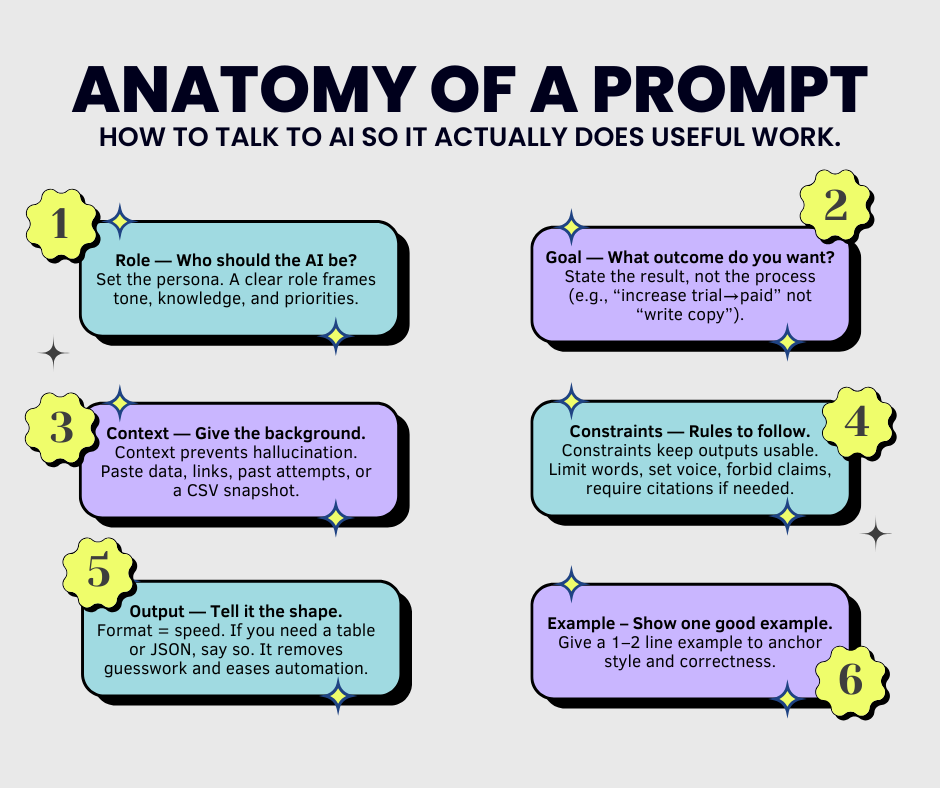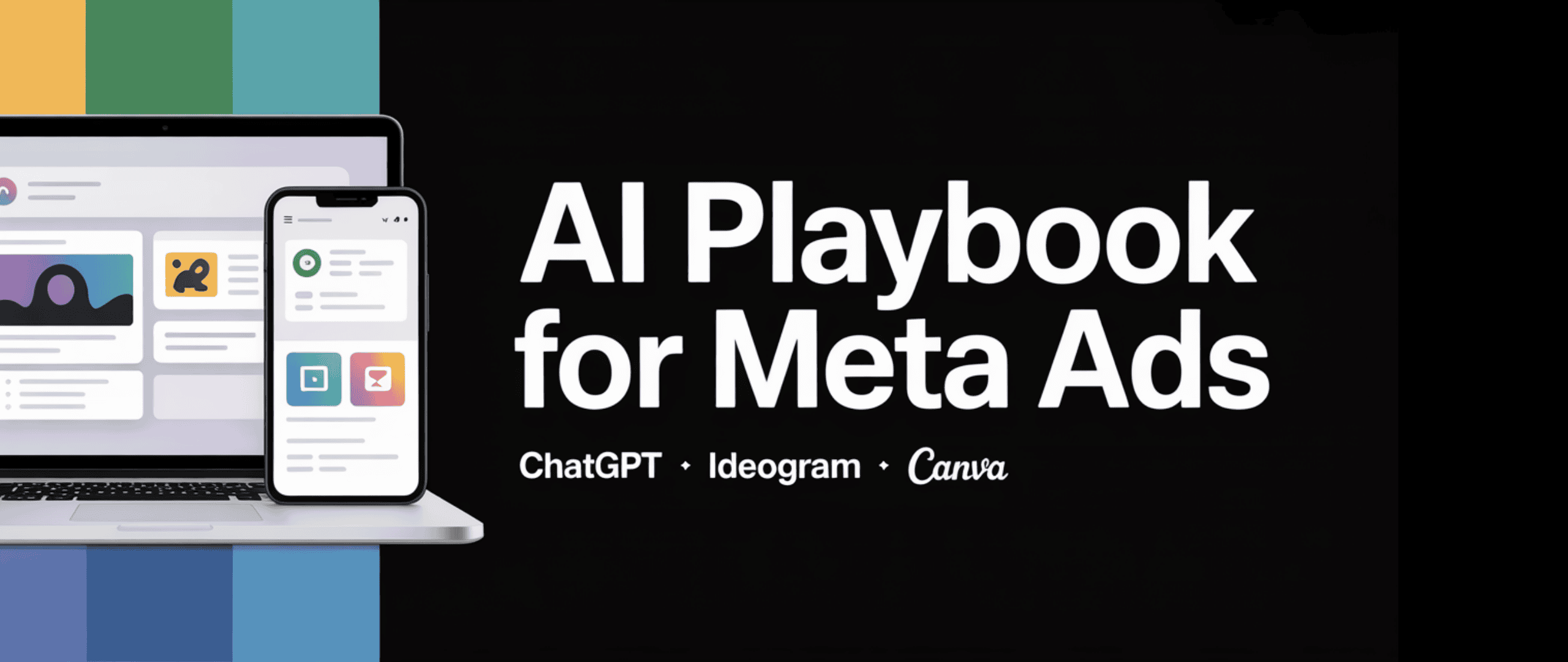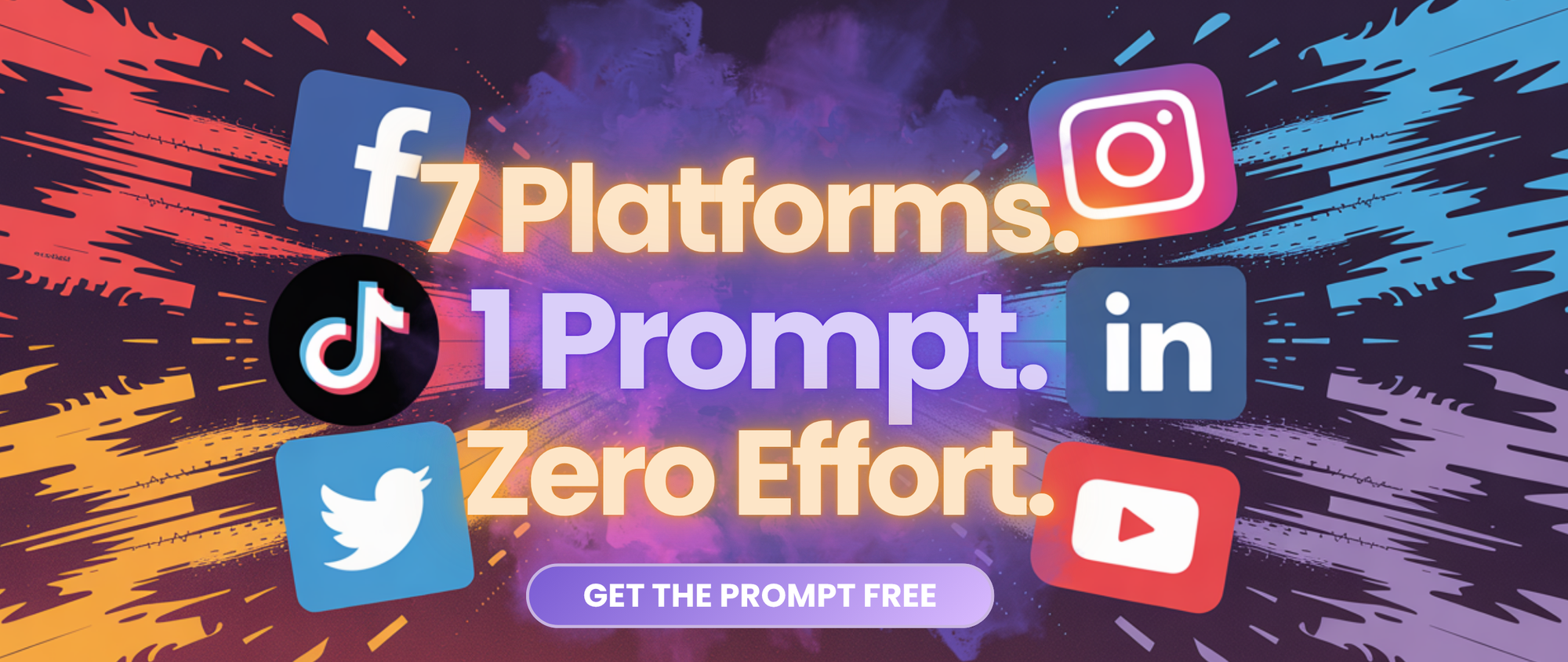What Is a Prompt? — The iFlow Guide to Prompt Fluency
This is the gateway page for iFlow’s Prompt Library — the place to learn, test, and copy real-world prompts that actually ship work. Read this once, come back forever. We’ll make prompts boringly reliable.
Why this matters (TL;DR for busy humans)
- AI is only as useful as the instructions you give it. Poor instructions = garbage outputs.
- Prompt fluency = professional leverage: faster workflows, fewer revisions, better automation.
- We focus on outcomes, not model worship. Good prompts deliver business results.
Pick your onboarding level
| For | Explanation |
|---|---|
| Kid-friendly | A prompt is asking the AI something clear — like "draw a dog wearing sunglasses." |
| Curious teen | A prompt is a set of words and examples that tell an AI what you want, how to say it, and how to format the answer. |
| Practical adult | A prompt = role + goal + context + constraints + output format. It’s the contract you make with the model. Better contract → fewer surprises. |
Anatomy of a Good Prompt — the single pattern to steal
Prompt = Role + Goal + Context + Constraints + Output Format + Example (optional)
[Role] You are a senior growth marketer.
[Goal] Write a 3-email onboarding sequence to increase trial-to-paid conversion.
[Context] SaaS product for freelance designers, 14-day trial, onboarding email already sent on day 0.
[Constraints] Each email ≤ 120 words, friendly and slightly irreverent, include an example CTA.
[Output Format] Numbered bullets with subject lines + body copy.
[Example] Email 1 subject line: "Your new design sidekick (ps: it installs in 60s)"
Bad prompt vs Good prompt — quick comparison
| Problem | Bad prompt | Good prompt (copyable) |
|---|---|---|
| Vague results | "Write an email sequence." | You are a growth marketer. Write a 3-email onboarding sequence (≤120 words each) for a SaaS product for freelance designers. Tone: confident, slightly irreverent. Output: numbered list with subject + body + CTA. |
| Wrong format | "Give me a list." | Return a markdown table with 3 columns: step, action, expected KPI. |
| No role/context | "Explain SEO." | You are a senior content strategist. Explain SEO to a founder who hates marketing in 4 bullets with one growth hack. |
Prompt engineering vs Context engineering — a necessary hot take
- Prompt engineering = optimizing the words you feed a model. Useful, basic skill.
- Context engineering = building persistent memory, datasets, tool calls, example chains, and workflows that the model consumes. This is where reliability lives.
iFlow's bias: context engineering wins when you're building real automations. Treat prompts as the UI layer; treat context (data + examples + tools) as the engine.
Prompt Library: Categories & Starter Prompts
Below are copy/paste-ready prompts grouped by use-case. Tweak the [placeholders].
Tip: always include a short instruction for the model aboutTone,Length, andOutput format.
Marketing — Growth & Copy
Email onboarding (SaaS)
You are a senior growth marketer. Goal: Write a 3-email onboarding series for [PRODUCT], a SaaS for [AUDIENCE]. Constraints: each email ≤120 words; tone: helpful + slightly irreverent; include one clear CTA. Output: numbered list with subject line + 2-3 sentence body + CTA.Facebook ad variations (A/B test 5)
You are a senior ad copywriter. Create 5 Facebook ad variations for [PRODUCT]. Each: a 25–40 character headline, 90 char primary text, 1 CTA. Tone: urgent but sincere. Add 1 sentence on target angle for each ad.
Workflow & Automation — Ops & Reports
Weekly client report summarizer
You are an operations analyst. Summarize this raw client report into a 1-paragraph executive summary and 3 bullets of recommended actions. Data: [PASTE CSV or key metrics]. Output: markdown with H2+bullets.Automated follow-up for leads
You are a sales ops specialist. Given this lead data: [NAME, COMPANY, LAST_TOUCH, INTEREST_LEVEL], generate a 3-email follow-up cadence with subject lines, short bodies, and next-step asks. Tone: helpful, not pushy.Research & Insights
Competitor landscape (quick)
You are a market researcher. Summarize competitor landscape for [CATEGORY]. Return a 3-row markdown table: Competitor | Strength | Weakness | One opportunity we can own.Summarize research paper
You are a research summarizer. Condense the following paper into: 1-sentence TL;DR, 3 bullet key findings, 2 questions this raises. Paper: [PASTE ABSTRACT OR LINK].Creative — Content & Ideation
Short blog outline
You are a content strategist. Create a blog outline for "How to use prompts to automate marketing workflows" — include H1, H2s, 5 bullet points under each H2, and 3 recommended CTAs.You are a social strategist. Give 10 Twitter/X thread hooks about 'prompt fluency', each with a 1-sentence hook and 5 tweet bullets.
Agent / Multi-step workflows
Agent prompt to run a research + outreach flow
You are an AI agent orchestrator.
Step 1: find 5 leads in [INDUSTRY] with emails and LinkedIn profiles.
Step 2: summarize their recent pain points.
Step 3: draft a personalized outreach message for each.
Output: JSON array with fields: name, company, pain_summary, outreach_draft.Note: Only run tool-invoking agents if you have connectors and privacy consent.
Prompt Templates — Fill & Ship (copyable)
Template: Role-Goal-Context-Constraints-Format
You are a [ROLE].
Goal: [WHAT YOU WANT].
Context: [ONE SENTENCE BACKGROUND].
Constraints: [MAX LENGTH, TONE, DO/DO NOT].
Output: [FORMAT — bullet list, markdown table, JSON, etc.].
Example: [OPTIONAL EXAMPLE OUTPUT].Template: Quick micro-prompt
Short: [precise ask].
Example: [one-line example].
Return: [single-sentence / 3 bullets / table].How to test & iterate — the iFlow 5-step loop
- Seed & Run: Start with a clear Role + Goal + Format.
- Inspect: Look at structure first (headings, list items), then tone and facts.
- Refine: Add constraints or examples. If output too long, limit words.
- Chain: Break complex tasks into steps (extract → transform → produce).
- Automate: When stable, turn into a function in your workflow (Zapier / n8n / Make / custom agent).
Mini checklist before automating:
- Output consistent 9/10 times
- Edge cases handled (null data, empty fields)
- Recognizable error messages to trap failures
- Safe data handling & privacy checked
Table: Prompt → Automation mapping (where to use what)
| Prompt Type | Best For | Automation-ready? | Notes |
|---|---|---|---|
| Templated copy (ads, emails) | Rapid content A/B | ✅ | Use variants + rate-limits; integrate into campaign flows. |
| Data summarizer | Reports & dashboards | ✅ | Needs structured inputs (CSV/JSON) for consistency. |
| Research extractor | Market intelligence | ⚠️ | Validate facts — human-in-loop recommended. |
| Personalized outreach | Sales sequences | ⚠️ | Mind privacy & spam rules; throttle sends. |
| Agent orchestrator | Multi-step workflows | ✅ | Use connectors + monitoring; add robust error-handling. |
Examples: From meh → pro (3 real rewrites)
1) Product description
You are a product copywriter. Write a 2-paragraph product description for [PRODUCT], a SaaS that helps freelance designers manage invoices. Tone: concise, empathetic. Include 1 short bullet list of features and a 12-word CTA.✅ Your Prompt After 5 day mini course from iFlow.bot School
2) Meeting summary
You are an executive assistant. Summarize the meeting notes below into: 1) three action items with owners & deadlines, 2) two decisions taken, 3) one risk to watch. Output: markdown list.✅ Your Improved Prompt After iFlow.bot School
3) Blog outline
You are a content strategist. Draft a blog outline: H1, five H2s, 3 bullets per H2, suggested word count per section, and 3 SEO keywords to target: [keyword1, keyword2, keyword3].✅ Your Prompt After iFlow.bot School
Best practices / hard rules – iFlow commandments
- Always state the role. The model performs better when asked to
besomething. - Give an output format. If you want a table — ask for a table.
- Limit length for predictable results.
- Use examples to anchor style.
- Prefer step-chaining for complex jobs. One job per prompt is better than one prompt that does eight things.
- Validate critical facts — models hallucinate. Use them to draft, not to certify legal/medical claims.
Source: OpenAI Academy
Privacy & safety note (short)
When automating, don't send PII to unknown models. Mask or hash sensitive fields. Always audit outputs before sending to customers.


